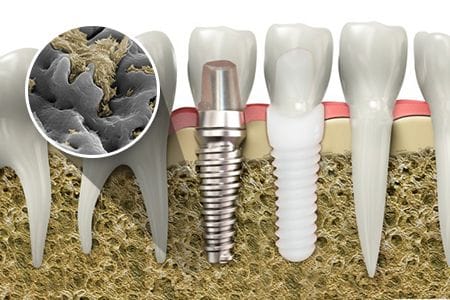What is Osseointegration?
Requirements For Any Successful Dental Implant Treatment
Osseointegration is a vital part of any successful dental implant treatment, and it is a term you will frequently hear during your consultations with the dental implant specialist in Brooklyn Dr. Leonard Umanoff.
Osseointegration
 The term is derived from the Greek word for bone, which is ‘osteon’ and the Latin word integrate, which means to ‘make whole again.’ Osseointegration is a process that must occur between your living jawbone and the artificial surface of your dental implants.
The term is derived from the Greek word for bone, which is ‘osteon’ and the Latin word integrate, which means to ‘make whole again.’ Osseointegration is a process that must occur between your living jawbone and the artificial surface of your dental implants.
Once your implant post is inserted surgically into your jaw, it requires several months to osseointegrate or heal. Usually, an implant post needs between three and six months for osseointegration.
During this time, new bone cells form around the post and on it, gradually building a strong framework of new bone that will fuse the implant post in position.
When finished, your implant post will be an integral part of your jawbone and is strong enough to support your new implant restoration.
How Dental Implant Posts Encourage Osseointegration
Titanium and zirconia dental implants are highly biocompatible, but measures are taken to increase this biocompatibility by treating the implant posts. Some dental implants have a hydroxyapatite coating. Hydroxyapatite is naturally found in bone and helps to encourage new bone growth. Other dental implants are etched, increasing the surface area for osseointegration.
The greater the surface area, the more bone cells can form on the implant post, helping to secure it more strongly in the jawbone. Some dental implants are coated with other substances like plasma and which also encourages new bone growth.
Dental Implants Mustn’t Move During Osseointegration
While the implants osseointegrate with your jawbone, it is critical to prevent any movement, and they cannot come under any substantial pressure. Traditionally, dental implants are covered with gum tissue or are fitted with a protective healing cap after surgery, ensuring they remain undisturbed during healing. During this time, patients are supplied with a temporary prosthesis that allows them to eat and to talk comfortably.
Once healing is finished, the implant is uncovered, is fitted with an abutment, and the permanent prosthesis is made and fitted. Sometimes, it is possible to fit implant teeth much sooner and even on the same day of surgery using immediate load dental implant technique, but this is only possible when we fabricate the prosthesis in such a way as to prevent any movement to the dental implants.
Requirements for Immediately Loading Dental Implants
With a single implant crown, it is possible to attach a temporary implant crown that will be specifically shaped to avoid contact with the opposing jaw during chewing. This will protect the dental implant until it has had time to heal and to osseointegrate.
Full Arch Restorations
With full arch dental implants and all on 6 dental implants, in particular those meant to replace loose dentures, the implants are inserted at precise angles so that when they are loaded with a new arch of teeth, they will be locked in position and unable to move.
Mini Dental Implants
Mini dental implants can also be used to stabilize loose denture. They are still made from the same high quality titanium alloy implants but their smaller size increases the versatility of treatment.
Questions
If you have any questions about Osseointegration in Brooklyn NY or to make an appointment with leading implant specialist and top dental implant dentist in Brooklyn please call our Sheepshead Bay, Brooklyn dental implants center:

